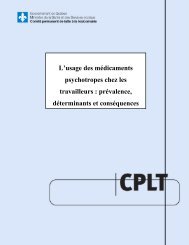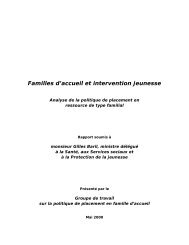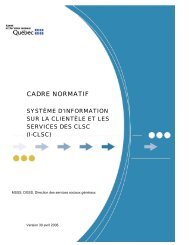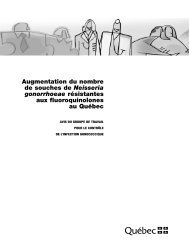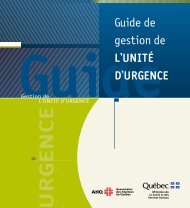De l'innovation au changement - Gouvernement du Québec
De l'innovation au changement - Gouvernement du Québec
De l'innovation au changement - Gouvernement du Québec
Create successful ePaper yourself
Turn your PDF publications into a flip-book with our unique Google optimized e-Paper software.
Projet 16<br />
Impact of a discharge coordinator on the sucessful discharge<br />
of elderly patients from the emergency department (ED),région de Montréal<br />
Impact d’un coordonnateur des congés <strong>au</strong> département d’urgence (DU)<br />
sur le succès <strong>du</strong> congé des patients âgés<br />
In the intervention phase, however, patients consented not only to the study interview but also to being seen by a nurse who would assist<br />
them with their discharge care and on whom they could call upon over a 7 day period post discharge. Those patients who were less frail,<br />
were now more likely to refuse participation stating that they did not need to see a nurse or their problem was not so severe as to warrant a<br />
nursing intervention. Those patients who were more frail were now more likely to participate bec<strong>au</strong>se they were now being offered the<br />
benefits of extra nursing services.<br />
5. BILAN DE L’EXPÉRIMENTATION<br />
5.1 Résultats Patient Characteristics: There were no significant differences between the groups with respect to mean age (82 years), gender, marital<br />
status, ability to speak English or French, or in level of e<strong>du</strong>cation and income. But several differences were noted in patient health<br />
characteristics between groups. The patients in the intervention group reported significantly more heart disease (43% vs 38%), diabetes<br />
(19% vs 15%), and mobility problems (14% vs 10%). They exhibited a higher complexity medication score (20.8 vs 17) and were less<br />
functionally <strong>au</strong>tonomous (51% vs 59%). In the area of social support, the intervention group reported less availability of a caregiver (34%<br />
vs 23%) and more social impairment (31% vs 21%).<br />
Unsche<strong>du</strong>led return : A difference in unsche<strong>du</strong>led revisits to the ED between the control and intervention phase was demonstrated at both<br />
8 and 14 days post discharge. Unsche<strong>du</strong>led revisits were decreased by 27 % at Day 8 (8.5% vs 11.6%) and by 19% (12.9% vs 16.1%) at<br />
Day 14. This translated into a statistically significant odds ratio for revisits of 0.71 at Day 8. Although the odds ratio of 0.78 at day 14 did<br />
not reach statistical significance, the 95% confidence intervals demonstrate that there is potentially a clinically significant decrease in return<br />
visits even at 14 days. The absolute risk re<strong>du</strong>ction of 3.1% seen at Day 8 is maintained at Day 14 reflecting our belief that the major impact<br />
of the discharge planner would be seen in the first week ie. <strong>du</strong>ring the period of nursing intervention and that this impact was carried<br />
forward.<br />
A significant difference was found in the perceived severity of presenting illness and baseline functional <strong>au</strong>tonomy between the two groups.<br />
Patients in the intervention phase had a higher perception of severity of illness at presentation and had a lower level of functional<br />
<strong>au</strong>tonomy.<br />
Unsche<strong>du</strong>led hospital admissions : The absolute number of unsche<strong>du</strong>led hospital admissions within 14 days of ED discharge is small in<br />
both the control (47) and intervention (39) groups. Hence, no significant conclusions can be drawn with respect to the influence a<br />
discharge planner may have on hospital admissions.<br />
Health and Welfare of the Target Population : Our study was of too short a time interval (2 week assessment) to have a major impact on<br />
general health indicators. However, a few points are worth noting. The population studied, by nature of their age, is at a high risk for<br />
morbidity. Nevertheless, the intervention group seems to have a positive benefit, in that, fewer of these patients revisited the ED <strong>du</strong>ring the<br />
study period, were more compliant with their medications and generally felt better by one week.<br />
Compliance with medication : Overall, compliance to new medications was high in both groups with a slight favouring of the intervention<br />
group (96.8% vs 92.8%)<br />
Well being: One of the basic questions in clinical studies is whether the intervention has resulted in a patient who feels better. We<br />
addressed this by simply asking the patients to rate how they felt at day 8 compared to the day of discharge. We found that 64.5% vs<br />
58.8% felt better in the intervention group (absolute difference 5.8%, 95%CI 0.4-11.9%). This translated to an odds of improvement of 1.3<br />
83





